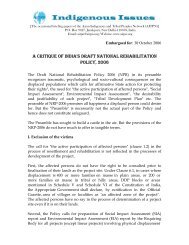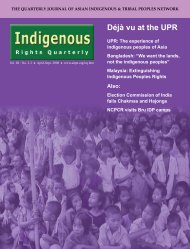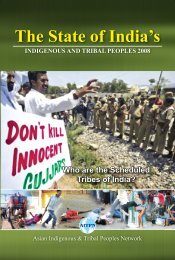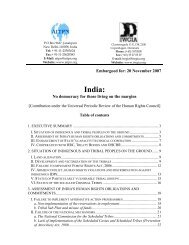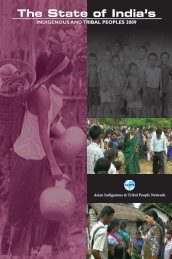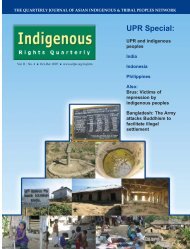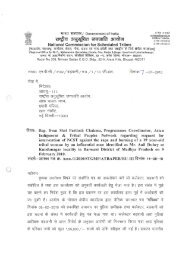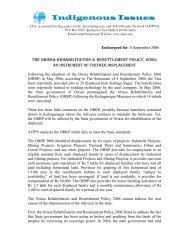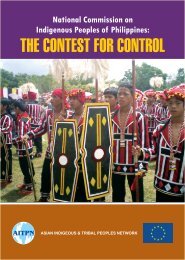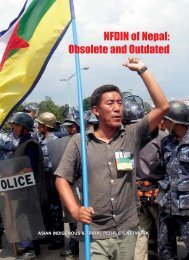india's forest rights act of 2006 - Asian Indigenous and Tribal ...
india's forest rights act of 2006 - Asian Indigenous and Tribal ...
india's forest rights act of 2006 - Asian Indigenous and Tribal ...
- No tags were found...
Create successful ePaper yourself
Turn your PDF publications into a flip-book with our unique Google optimized e-Paper software.
INDIA'S FOREST RIGHTS ACT OF <strong>2006</strong>:Illusion or solution?3initiated with so much fan fare to undo what it calls “historic injustice” thatthe <strong>forest</strong> dwelling Scheduled Tribes have been facing.II. Mixing oranges with applesThe Scheduled Tribes <strong>and</strong> Other Traditional Forest Dwellers (Recognition <strong>of</strong>Forest Rights) Act, <strong>2006</strong> sought to mix oranges with apples. While tribals <strong>and</strong><strong>forest</strong> are synonymous <strong>and</strong> one cannot be separated from the other, same isnot the case with the “other traditional <strong>forest</strong> dwellers” i.e. non tribals.<strong>Tribal</strong>s have emotional, psychological <strong>and</strong> cultural attachments with the<strong>forest</strong> <strong>and</strong> they always lived in the <strong>forest</strong>. On the other h<strong>and</strong>, for non tribal<strong>forest</strong> dwellers, <strong>forest</strong> <strong>and</strong> <strong>forest</strong> related livelihood <strong>act</strong>ivities are the last resortwhen no other options <strong>of</strong> livelihood were left. Non-tribals usually do not takelivelihood <strong>act</strong>ivities in <strong>forest</strong> by choice. However, by legitimising theiroccupation <strong>of</strong> the <strong>forest</strong> l<strong>and</strong>s under the guise <strong>of</strong> “Other Traditional ForestDwellers”, the Act negated the spirit <strong>of</strong> the various safeguards available to themembers <strong>of</strong> the Scheduled Tribes under the Constitution <strong>and</strong> other relevantlaws <strong>of</strong> the country.Rather than improving the lot <strong>of</strong> the tribals, the Act will lead to conflict <strong>of</strong>interest between the <strong>forest</strong> dwelling Scheduled Tribes <strong>and</strong> other traditional<strong>forest</strong> dwellers.III. Extension <strong>of</strong> cut-<strong>of</strong>f dateAnother conspicuous feature <strong>of</strong> the Scheduled Tribes <strong>and</strong> Other TraditionalForest Dwellers (Recognition <strong>of</strong> Forest Rights) Act, <strong>2006</strong> is the extension <strong>of</strong> thecut-<strong>of</strong>f date to qualify for holding <strong>of</strong> <strong>rights</strong> from 25 October 1980 to 13December 2005. At the ground level, the cut <strong>of</strong>f date is quite immaterial to themajority <strong>of</strong> the <strong>forest</strong> dwelling Scheduled Tribes as they have been living inthe <strong>forest</strong> for generations <strong>and</strong> as such they would have been covered evenunder the 25 October 1980 cut <strong>of</strong>f date. This extension <strong>of</strong> the cut <strong>of</strong>f date isbasically to benefit the other traditional <strong>forest</strong> dwellers who are required toprove that they have been occupying the <strong>forest</strong> l<strong>and</strong> for three generationsunder clause (o) <strong>of</strong> Section 2 <strong>of</strong> the Act. By extending the date from 25October 1980 to 13 December 2005, one generation has already been covered!<strong>Indigenous</strong> Issues – The Occasional Briefing Papers <strong>of</strong> AITPN
INDIA'S FOREST RIGHTS ACT OF <strong>2006</strong>:Illusion or solution?4IV. Increase in the ceiling on l<strong>and</strong> occupationSub-section (6) <strong>of</strong> Section 4 states, “Where the <strong>forest</strong> <strong>rights</strong> recognized <strong>and</strong>vested by sub-section (1) are in respect <strong>of</strong> l<strong>and</strong> mentioned in clause (a) <strong>of</strong> subsection(1) <strong>of</strong> section 3 such l<strong>and</strong> shall be under the occupation <strong>of</strong> anindividual or family or community on the date <strong>of</strong> commencement <strong>of</strong> this Act<strong>and</strong> shall be restricted to the area under <strong>act</strong>ual occupation <strong>and</strong> shall in no caseexceed an area <strong>of</strong> four hectares.”This provision hardly benefits the Scheduled Tribes. Rather thanempowering, this law seeks to dispossess the <strong>forest</strong> dwelling ScheduledTribes <strong>of</strong> their ancestral l<strong>and</strong>s that they have in possession in excess <strong>of</strong> 4hectares as provided in Sub-section (6) <strong>of</strong> Section 4. Nor the Bill provides forcompensation to those who will be forced to share their l<strong>and</strong>s in excess <strong>of</strong> 4hectares.A large number <strong>of</strong> <strong>forest</strong> dwelling Scheduled Tribes would have tom<strong>and</strong>atorily part with large chunks <strong>of</strong> ancestral l<strong>and</strong>s that they have been<strong>act</strong>ually occupying before the en<strong>act</strong>ment <strong>of</strong> this Act. The provision is alsoinapplicable in the northeast India.V. Criminals under the Forest Conservation Act <strong>of</strong> 1980The Scheduled Tribes <strong>and</strong> Other Traditional Forest Dwellers (Recognition <strong>of</strong>Forest Rights) Act, <strong>2006</strong> has not taken into account the f<strong>act</strong> that hundreds <strong>of</strong><strong>forest</strong> dwelling scheduled tribes face charges under different provisions <strong>of</strong> thedraconian Forest Conservation Act <strong>of</strong> 1980 for accessing minor produce.Although the Scheduled Tribes <strong>and</strong> Other Traditional Forest Dwellers(Recognition <strong>of</strong> Forest Rights) Act, <strong>2006</strong> ensures tenurial security <strong>and</strong>legitimizes the scheduled tribes' ownership over the minor <strong>forest</strong> produce<strong>and</strong> their role in the conservation <strong>of</strong> <strong>forest</strong>, it failed to addresscharges/prosecution pending against the tribals under the ForestConservation Act <strong>of</strong> 1980 <strong>and</strong> Indian Forest Act <strong>of</strong> 1927 with retrospectiveeffect.There is no provision in the Forest Dwelling Scheduled Tribes <strong>and</strong> OtherTraditional Forest Dwellers (Recognition <strong>of</strong> Rights) Act, <strong>2006</strong> providing thatcases under the Forest Conservation Act <strong>of</strong> 1980 against the <strong>forest</strong> dwellingscheduled tribes for accessing minor <strong>forest</strong> produce would be dropped orclosed.<strong>Indigenous</strong> Issues – The Occasional Briefing Papers <strong>of</strong> AITPN
INDIA'S FOREST RIGHTS ACT OF <strong>2006</strong>:Illusion or solution?5There were 2,57,226 <strong>forest</strong> cases pending against 1,62,692 tribals between 1953to 30 June 2004 under Sections 26, 33 <strong>and</strong> 41 <strong>of</strong> the Indian Forest Act 1927pertaining primarily to illegal felling <strong>of</strong> trees for domestic use <strong>and</strong> ferrying <strong>of</strong>wood by bullock carts in Chhattisgarh as on 8 November 2005,[2] <strong>and</strong> 2,531such cases in Orissa as on 10 March 2005.[3]The bias <strong>of</strong> the police <strong>and</strong> the <strong>forest</strong> department against the tribals is wellknown.In Jharkh<strong>and</strong>, a criminal case was registered against 4 minor tribalboys <strong>of</strong> Matrukha village in Giridih district <strong>of</strong> Jharkh<strong>and</strong>. The minors havebeen accused <strong>of</strong> destroying over 541 plants in the Purnanagar <strong>forest</strong>ation areaby bringing their cattle to the <strong>forest</strong> area for grazing. When the FirstInformation Report was registered on 18 September 2002, one <strong>of</strong> the accusedSone Lal, son <strong>of</strong> Gushaw Kishku <strong>of</strong> Matrukha village was just over 14 monthsold. On 18 December <strong>2006</strong>, the minor boy, along with his father, appearedbefore the court <strong>of</strong> Judicial Magistrate A.K. P<strong>and</strong>ey applied for bail <strong>and</strong> filed adischarge petition. By the end <strong>of</strong> the <strong>2006</strong>, the case was pending.[4]The Scheduled Tribes (Recognition <strong>of</strong> Forest Rights) Bill, 2005 re-christened as“The Scheduled Tribes <strong>and</strong> Other Traditional Forest Dwellers (Recognition <strong>of</strong>Forest Rights) Act, <strong>2006</strong>” was brought essentially to circumvent the SupremeCourt's order in the case <strong>of</strong> Godavarman Thirumalpad vs Union <strong>of</strong> Indiawhich banned regularization <strong>of</strong> tribal revenue villages. When the government<strong>of</strong> India passed the Forest Conservation Act on the mid-night <strong>of</strong> 25 October1980, hundreds <strong>of</strong> thous<strong>and</strong>s <strong>of</strong> indigenous/tribal peoples became illegalresidents on l<strong>and</strong> over which they have been living for generals. Yet,thous<strong>and</strong>s <strong>of</strong> others also had legal <strong>rights</strong> under the Forest Conservation Act.For two <strong>and</strong> half decades, the state governments failed to record <strong>and</strong>recognize even limited those ancestral <strong>rights</strong> <strong>of</strong> tribal communities permittedby the Forest Conservation Act <strong>and</strong> the subsequent 1990 Guidelines issued bythe Ministry <strong>of</strong> Environment <strong>and</strong> Forest. After the Supreme Court stayed theregularisation <strong>of</strong> revenue villages on 23 November 2001 in the aftermath <strong>of</strong>Godavarman Thirumalpad vs Union <strong>of</strong> India, all the tribals living in the <strong>forest</strong>irrespective <strong>of</strong> whether their <strong>rights</strong> were recognize under the 1980 ForestConservation Act or nor were effectively extinguished.The government essentially sought to address the denial <strong>of</strong> <strong>rights</strong> to thetribals. “The Scheduled Tribes <strong>and</strong> Other Traditional Forest Dwellers(Recognition <strong>of</strong> Forest Rights) Act, <strong>2006</strong>” did not address the concerns <strong>of</strong> the<strong>Indigenous</strong> Issues – The Occasional Briefing Papers <strong>of</strong> AITPN
INDIA'S FOREST RIGHTS ACT OF <strong>2006</strong>:Illusion or solution?6environmentalists but certainly they were successful to further erode the<strong>rights</strong> <strong>of</strong> the tribals.ENDNOTES:[1]. Report <strong>of</strong> the National Consultation on the Draft Forest Rights Bill, 2005, AITPN, October2005[2]. Over two lakh <strong>forest</strong> cases against Chhattisgarh tribals to be withdrawn, The Hitavada, 11November 2005[3]. Naxalite bodies dem<strong>and</strong> probe into police firing, The Statesman, 14 March 2005[4]. Criminal case against 5-year-old, The Hindustan Times, 21 December <strong>2006</strong><strong>Indigenous</strong> Issues – The Occasional Briefing Papers <strong>of</strong> AITPN



